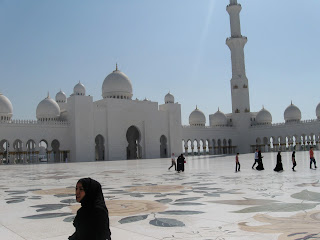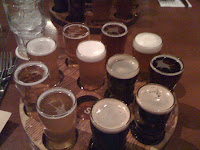If what's happening in Barcelona was ever a secret, the proverbial cat is certainly out of the bag. The consensus among chefs and food critics of late is that something big is happening in Spain, and that it tastes good...really good.
Not knowing any other way to organize the sensory explosion that is dining in Barcelona, I'm simply going to sum up my favorite experiences:
1. La Boqueria:
La Mercat de Sant Josep de la Boqueria is the official name for Barcelona's central market, nestled just back from the bustling crowds and pickpockets of La Rambla. That rule about not shopping while you're hungry probably started here, as the market has been around in some form since the 1200s. In the United States, we've become accustomed to a trade off between quantity and quality when it comes to grocery shopping. We can shop at the supermarket where we find vast quantities of acceptable produce, fish, or meat; alternatively, we can visit a boutique grocer offering smaller amounts of high quality food, at higher prices. No such trade off exists in Barcelona. The displays of legions of hanging pork legs, great walls of fruits and vegetables, and towers of spices are dazzling not just for their quantity and beauty, but also for their easily apparent quality.
2. Tapas and Pintxos:
The great thing about so many tapas is their simplicity; finely sliced, fatty ham (pernil) on bread, or oil-soaked mussels that melt in your mouth. These aren't complicated dishes, just simple morsels of goodness. Some of my favorite Barcelona food wasn't Catalan, but Basque. Pintxos, which are basically like tapas on bread, were perfect for someone who loves bread as much as I do, and they end up being much more filling. A couple of solid places are Euskal Etxea (pintxos), and El Xampanyet (a cava bar), both near the Picasso Museum.
3. Molecular Cuisine:
The meal I enjoyed at Cinc Sentits (Five Senses) was one of the most memorable of my life, not only because of how good the food tasted, but because of how it was arranged. Molecular cuisine is the pioneering field of superstar chef Ferran Adria, whose restaurant in Roses (just over the mountain from Cadaqués) is regarded by many as the best in the world. The idea is that taste and texture don't necessarily have to be tied together by their natural occurrences. Perhaps instead of grilling onions, a chef might construct a foam that tastes like grilled onions, and top his dish with that. Cinc Sentits offers both a traditional and an "adventurous" menu, which is mildly molecular. It mostly focuses on modern interpretations of old Catalan classics. Dinner started out with a shot of a sweet, honey-tasting concoction with a salty layer of foam on top that, when taken, mixed into a salty sweet elixir all at once. The glaze for the tenderloin was layered on in a gelatin-like substance and none of the side dishes looked like one would expect. I'm kicking myself for not keeping a copy of the menu, because I have no idea what I ate even from looking at the pictures.
4. Dessert:
The most surprising thing about Barcelona is that there aren't half-ton people walking around like there are in the good 'ole U.S. of A. Barcelona's desserts and sweets are ridiculously decadent. The staple dessert/meal replacement is churros and chocolate, basically fried dough that you dip into a vat of melted chocolate. On the healthier side, there's the simple choice of yogurt and honey. Finally, there are an endless number of shops serving up all kinds of pastry concoctions, including merengues, which are formed sugary spires, kind of like hardened mounds of cupcake frosting.
5. Cal Pep:
Cal Pep is a tapas restaurant, albeit an expensive one. But it was worth every penny, as my stomach is moaning in remembrance of my meal there as I write this. It has all the great elements of a Spanish eatery; a loud, noisy bar where people eat shoulder-to-shoulder, fresh ingredients sitting right before your eyes, and an eccentric, but brilliant chef. Josep "Pep" Manubens is a character so cartoon-like that he actually has caricatures of himself hanging on the walls, and on his business cards. His graying hair is slicked back, and his purple wire glasses accentuate his slightly pudgy face. He also wears a massive watch so ridiculous one would only expect to find it on the wrist of 50-cent or Kanye West. He barks orders in a raspy, smoked way-too-many cigarettes kind of voice. The food is prepared right in front of the customers, who get to watch the chaos as they inhale the works of art that come off the grill. This place is truly special, and it makes a trip to Barcelona worth it all on its own.
6. Paying "la cuenta": Finally, a note on the exemplary business practices of Spanish restaurants. Instead of doing the awkward dance with the waiter at the end of the meal where they whisk your credit card away to some unknown place, doing God knows what with it, Spanish servers ring up your bill right at your table. Almost all of them are armed with a hand-held ServiRed card swipe terminal so they can swipe your card and get you to sign the receipt in one fell swoop. They wait until you've asked for the bill, check you out, and there's no frustrating period of waiting for your card when you have somewhere to be. I can't wait until this practice hops the pond and becomes more common here. Also, at the end of every meal guests are usually given a nice business card to keep the restaurant in their thoughts. For all the stereotypes about lazy Europeans and inefficient business practices, the restaurant industry in Spain seems to be doing well for itself.
Not knowing any other way to organize the sensory explosion that is dining in Barcelona, I'm simply going to sum up my favorite experiences:
1. La Boqueria:
La Mercat de Sant Josep de la Boqueria is the official name for Barcelona's central market, nestled just back from the bustling crowds and pickpockets of La Rambla. That rule about not shopping while you're hungry probably started here, as the market has been around in some form since the 1200s. In the United States, we've become accustomed to a trade off between quantity and quality when it comes to grocery shopping. We can shop at the supermarket where we find vast quantities of acceptable produce, fish, or meat; alternatively, we can visit a boutique grocer offering smaller amounts of high quality food, at higher prices. No such trade off exists in Barcelona. The displays of legions of hanging pork legs, great walls of fruits and vegetables, and towers of spices are dazzling not just for their quantity and beauty, but also for their easily apparent quality.
2. Tapas and Pintxos:
The great thing about so many tapas is their simplicity; finely sliced, fatty ham (pernil) on bread, or oil-soaked mussels that melt in your mouth. These aren't complicated dishes, just simple morsels of goodness. Some of my favorite Barcelona food wasn't Catalan, but Basque. Pintxos, which are basically like tapas on bread, were perfect for someone who loves bread as much as I do, and they end up being much more filling. A couple of solid places are Euskal Etxea (pintxos), and El Xampanyet (a cava bar), both near the Picasso Museum.
3. Molecular Cuisine:
The meal I enjoyed at Cinc Sentits (Five Senses) was one of the most memorable of my life, not only because of how good the food tasted, but because of how it was arranged. Molecular cuisine is the pioneering field of superstar chef Ferran Adria, whose restaurant in Roses (just over the mountain from Cadaqués) is regarded by many as the best in the world. The idea is that taste and texture don't necessarily have to be tied together by their natural occurrences. Perhaps instead of grilling onions, a chef might construct a foam that tastes like grilled onions, and top his dish with that. Cinc Sentits offers both a traditional and an "adventurous" menu, which is mildly molecular. It mostly focuses on modern interpretations of old Catalan classics. Dinner started out with a shot of a sweet, honey-tasting concoction with a salty layer of foam on top that, when taken, mixed into a salty sweet elixir all at once. The glaze for the tenderloin was layered on in a gelatin-like substance and none of the side dishes looked like one would expect. I'm kicking myself for not keeping a copy of the menu, because I have no idea what I ate even from looking at the pictures.
4. Dessert:
The most surprising thing about Barcelona is that there aren't half-ton people walking around like there are in the good 'ole U.S. of A. Barcelona's desserts and sweets are ridiculously decadent. The staple dessert/meal replacement is churros and chocolate, basically fried dough that you dip into a vat of melted chocolate. On the healthier side, there's the simple choice of yogurt and honey. Finally, there are an endless number of shops serving up all kinds of pastry concoctions, including merengues, which are formed sugary spires, kind of like hardened mounds of cupcake frosting.
5. Cal Pep:
Cal Pep is a tapas restaurant, albeit an expensive one. But it was worth every penny, as my stomach is moaning in remembrance of my meal there as I write this. It has all the great elements of a Spanish eatery; a loud, noisy bar where people eat shoulder-to-shoulder, fresh ingredients sitting right before your eyes, and an eccentric, but brilliant chef. Josep "Pep" Manubens is a character so cartoon-like that he actually has caricatures of himself hanging on the walls, and on his business cards. His graying hair is slicked back, and his purple wire glasses accentuate his slightly pudgy face. He also wears a massive watch so ridiculous one would only expect to find it on the wrist of 50-cent or Kanye West. He barks orders in a raspy, smoked way-too-many cigarettes kind of voice. The food is prepared right in front of the customers, who get to watch the chaos as they inhale the works of art that come off the grill. This place is truly special, and it makes a trip to Barcelona worth it all on its own.
6. Paying "la cuenta": Finally, a note on the exemplary business practices of Spanish restaurants. Instead of doing the awkward dance with the waiter at the end of the meal where they whisk your credit card away to some unknown place, doing God knows what with it, Spanish servers ring up your bill right at your table. Almost all of them are armed with a hand-held ServiRed card swipe terminal so they can swipe your card and get you to sign the receipt in one fell swoop. They wait until you've asked for the bill, check you out, and there's no frustrating period of waiting for your card when you have somewhere to be. I can't wait until this practice hops the pond and becomes more common here. Also, at the end of every meal guests are usually given a nice business card to keep the restaurant in their thoughts. For all the stereotypes about lazy Europeans and inefficient business practices, the restaurant industry in Spain seems to be doing well for itself.










































